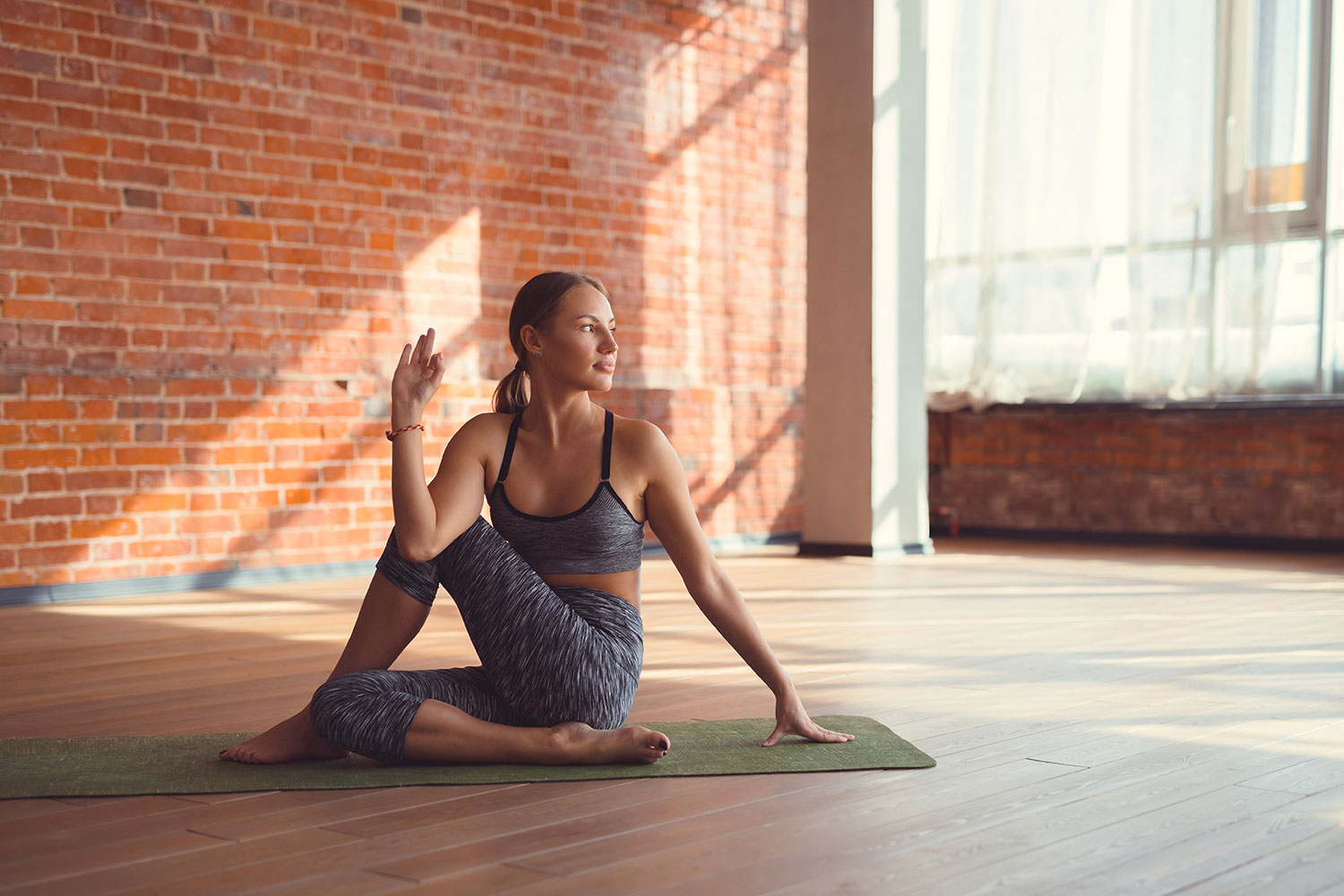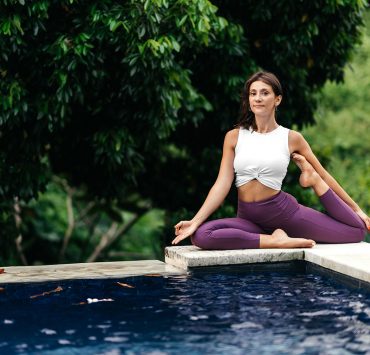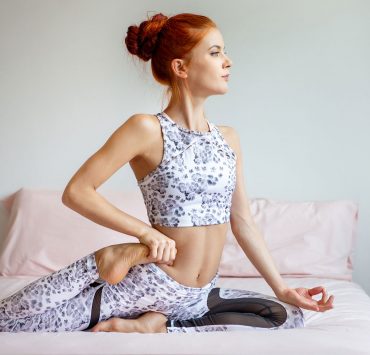
After spending nearly two decades as a relationship therapist, Patricia…
Are you craving a caffeine-free energy boost? Amidst the hustle and bustle of daily life, extra energy can be hard to come by. Many of us reluctantly depend on coffee or energy drinks for a quick pick-me-up, but did you know there’s a natural solution to your sleepy situation? Yes, you guessed it – Yoga! This thirty-minute routine has got you covered with a series of backbends, heart-openers, and mindful breathing. Opening the chest allows us to optimally fill the lungs and take deeper breaths, resulting in heightened energy and alertness. This sequence has been carefully designed to leave no stones unturned – You’ll finish feeling restored, rejuvenated, and ready for whatever comes your way! Get ready to breathe space into the tight spaces in your body, release tension and stress, and get the energy flowing!
Suyra Namaskar A — Sun Salutation A Pose
Uttanasana — Standing Forward Fold Pose

Start standing at the head of your mat with feet at hip-width. Exhale and hinge forward at the waist, letting the upper body drape towards the legs as the arms go heavy towards the floor. Maintain a generous bend in the knees as you create space in the lower back. With every exhale, release tension from the tailbone to the crown. Find movements that feel natural to you – Perhaps swaying side to side or shifting weight forward into the balls of the feet. Hold this position for three to five full cycles of breath.
Ardha Uttanasana — Standing Half Forward Fold

Inhale your fingertips to your shin bones as your spine becomes parallel to the floor. Keep your gaze forward as you draw the shoulders back and cultivate space in the hamstrings. Hold this position for one full breath.
Chaturunga Dandasana – Low Plank Pose

Exhale to step back to a high plank with wrists stacked under shoulders and the entire body engaged. Take a deep breath in and root down through the palms to expand across the upper back. Exhale and bend the elbows, lowering halfway down to the floor.
Bhujangasana — Cobra Pose or Urdhva Mukha Svanasana — Upward Facing Dog Pose

Inhale to enter either a cobra or upward facing dog pose. For a more gentle backbend, exercise cobra by lowering all the way to the floor and drawing the palms under the shoulders. Press through the tops of the feet and activate the back body as you slowly lift up. If you’re craving a deeper backbend, take upward facing dog by pressing the arms to straight and lifting the knee caps off the floor. Release back to the floor on the next breath out.
Adho Mukha Svanasana — Downward Facing Dog Pose

Root the palms and tuck the toes under as you send the hips skyward for a downward facing dog. Shift your tailbone towards the ceiling and create space in the backs of the legs. Surrender any tension being held in the back of the neck and shoulders by nodding ‘yes’ and ‘no.’ Take a few moments here to invite gentle movements into the posture, or continue to explore stillness. Hold this position for five full breaths before repeating this salutation on the other side.
Suyra Namaskar B — Sun Salutation B Pose
Utkatasana — Chair Pose

To begin the second sun salutation, start standing with the big toes touching and the heels slightly apart. Exhale and bend deep into the knees while sinking weight back into your heels as the arms extend overhead. Pull the navel in towards the spine, and you continue to drop low in the hips. Hold for three to five breaths.
Uttanasana — Standing Forward Fold Pose

From your chair position, exhale and hinge forward at the waist, letting the upper body drape towards the legs as the arms go heavy towards the floor. Maintain a generous bend in the knees as you create space in the lower back. With every exhale, release tension from the tailbone to the crown. Find movements that feel natural to you – Perhaps swaying side to side or shifting weight forward into the balls of the feet. Hold this position for three to five full cycles of breath.
Ardha Uttanasana — Standing Half Forward Fold

Inhale your fingertips to your shin bones as your spine becomes parallel to the floor. Keep your gaze forward as you draw the shoulders back and cultivate space in the hamstrings. Hold this position for one full breath.
Chaturunga Dandasana – Low Plank Pose

Exhale to step back to a high plank with wrists stacked under shoulders and the entire body engaged. Take a deep breath in and root down through the palms to expand across the upper back. Exhale and bend the elbows, lowering halfway down to the floor.
Bhujangasana — Cobra Pose or Urdhva Mukha Svanasana — Upward Facing Dog Pose

Inhale to enter either a cobra or upward facing dog pose. For a more gentle backbend, exercise cobra by lowering all the way to the floor and drawing the palms under the shoulders. Press through the tops of the feet and activate the back body as you slowly lift up. If you’re craving a deeper backbend, take upward facing dog by pressing the arms to straight and lifting the knee caps off the floor. Release back to the floor on the next breath out.
Adho Mukha Svanasana — Downward Facing Dog Pose

Root the palms and tuck the toes under as you send the hips skyward for a downward facing dog. Shift your tailbone towards the ceiling and create space in the backs of the legs. Surrender any tension being held in the back of the neck and shoulders by nodding ‘yes’ and ‘no.’ Take a few moments here to invite gentle movements into the posture, or continue to explore stillness. Hold this position for five full breaths.
Virabhadrasana I — Warrior I Pose

Inhale your right leg towards the sky for a three-legged downward facing dog variation and step your right foot up between the hands. Turn your left foot flat at a 45-degree angle and inhale to come up by squeezing the inner thighs together and reaching both arms up by your ears. Turn the palms to face as the shoulder blades and tailbone drop. Proceed to ground through the outside edge of your left foot as you bend deeply into the right knee and stretch the right hip back. Take five full breaths before repeating this salutation on the other side. Once you’ve finished the second side, stay in your warrior i pose to set up for the standing series postures.
Standing Series
Virabhadrasana II — Warrior II Pose

Starting in warrior i with your left foot forward, turn your right foot flat, so the front heel aligns with the back arch. Bring your arms out the sides in a T-shape with palms facing down and gaze beyond your left hand. Exhale to bend deep into the front knee, bringing your thigh parallel to the floor. Breathe through three to five full cycles.
Viparita Virabhadrasana — Reverse Warrior Pose

Staying in warrior ii, take a deep breath in to move the left arm overhead towards the back wall. Lower your right fingertips to the back leg and keep bending deep into the front knee. Breath space between each rib in the left side body for about one thirty seconds before inhaling back up to warrior ii.
Utthita Parsvakonasana — Extended Side Angle Pose

From warrior ii, bring the left hand down to the inside of the left foot, using a block if that feels appropriate, or rest the forearm on the thigh instead. Reach the right arm overhead, creating a line of energy from the fingertips out through the back foot. Hold for three to five breaths before rising back up to warrior ii.
Anjaneyasana — Crescent Pose

Starting in warrior ii, pivot onto the ball of the back foot as you reach both arms overhead. Turn your palms to face one another and let the shoulder blades relax. Take three to five full breaths before moving to the next posture.
Virabhadrasana III — Warrior III Pose

Virabhadrasana III — Warrior III PoseIn your high lunge, begin to shift your weight forward into the front foot. Step your back foot up halfway and inhale to lift your right foot off the ground. Reach your arms forward, trying to bring the arms, torso, and right leg parallel to the floor. Take three deep breaths before slowly stepping back into a high crescent lunge.
Parsvottanasana — Pyramid Pose

From a high lunge, step your right foot in roughly two feet behind the left with both legs straight. For the most intense version of the pose, bring hands to reverse prayer or grab opposite elbows behind the back. Another option is to place blocks around the front foot. Hinge forward from the waist, drawing the left hip back and keeping the chest open to bring space to the spine. Hold for five breaths before flowing to a downward facing dog and repeating the whole standing series on the other side.
Seated Series
Ustrasana — Camel Pose

Find a comfortable kneeling position, perhaps bringing a folded blanket under the knees. Bring your hands to the lower back with fingers facing up and elbows pulling together. Take a deep inhale to lengthen the spine, and as you exhale, begin to lean back. Lift the chest towards the ceiling and press the pelvis forward. Keep the hands where they are, bring them to blocks, or reach for the ankles. Whatever expression you choose, hold for thirty seconds.
Paripurna Navasana — Boat Pose

Make your way to your seat with knees bent and feet flat. Broaden across the collarbones and inhale your arms parallel to the floor. Inhale and slowly lift both feet off the floor by finding a neutral resting spot behind the sit bones. Keep the shins parallel to the floor, or for a more advanced option, straighten the legs. Breathe here for thirty seconds.
Upavistha Konasana — Wide-Angle Seated Forward Bend Pose

Find a comfortable seated position with legs straight out in a wide stance. Keep the feet flexed and avoid letting the thighs roll inward as you slowly relax forward into the pose. Use blocks or a bolster to support the upper body as you ease into a deep release. Hold for one minute.
Janu Sirsasana — Head-to-Knee Forward Bend

From a wide-legged forward fold, bend your right knee and bring the sole of the foot to your left inner thigh. Turn your torso to align over the left leg as you slowly fold the upper body down and create space in the back and side bodies. Stay here for thirty seconds on each side.
Ardha Matsyendrasana — Seated Twist Pose

From neutral a seated position, cross your left leg over the right and plant your left foot down. Depending on what feels best, you can bend or straighten the right leg to support a long spine. On an exhale, twist towards the left; starting from the base of the spine and working up to the crown. Stay in the twist for thirty seconds on each side.
Closing Postures
Supta Kapotasana – Reclining Pigeon Pose

Take care as you make your way down onto your back with knees bent and feet planted firmly. Cross your left ankle above your right knee, keeping the left foot flexed. Stay here, or reach up and clasp your hands around the right thigh to hug the leg towards you. Hold for about a minute on each side, rocking side to side if the movement feels appropriate.
Setu Bandha Sarvangasana — Supported Bridge Pose

Plant your feet at hip-width and extend both arms by your sides. Shift the shoulders slightly under the back to elevate the heart center. Root through the hands and feet simultaneously as you raise the pelvis on an inhale. Place a block or bolster under your tailbone and let your full body surrender to gravity. Stay here for one to three minutes, taking any leg variation that feels beneficial.
Viparita Karani — Waterfall Pose

Keeping the block under your sacrum, slowly bring one knee at a time toward your chest and lengthen both legs straight up towards the ceiling. Stay here for one to three minutes before gently bending both knees back towards the chest and replacing the feet on the mat. Press down into your feet to lift the hips and remove the block.
Supta Baddha Konasana — Reclining Bound Angle Pose

Draw the soles of the feet together and let the knees go heavy towards the sides, using blocks or blankets under the thighs as needed. Track the movement of breath in and out by placing one hand on your belly and the other on your heart. Allow the eyes to settle back into the head, and the muscles of the face, neck, and jaw to soften. Stay here for one to three minutes, using the stillness to check in and tune out.
Savasana — Corpse Pose

For your final resting posture, extend both legs straight and rest your arms by your side. Let your entire body surrender into the mat, employing props to deepen the experience as necessary. Stay here as long as you need to fully absorb the benefits of your practice.
What's Your Reaction?
After spending nearly two decades as a relationship therapist, Patricia journeyed down the path of writing as a vehicle for sharing her wisdom. Her work reflects a sincere interest in readers’ wellbeing and is abundant with helpful advice and fascinating insight.














